One of my most memorable travel experiences was a morning spent whale watching in Monterey California. We’d already had a fantastic time the day before wildlife spotting in Monterey as we walked the length of the bay.
That paled in the shadow of the epic boat trip we took the following day. Whale watching in Monterey Bay was the most memorable day of our two-week road trip and one which I’d been looking forward to since we arrived in California.
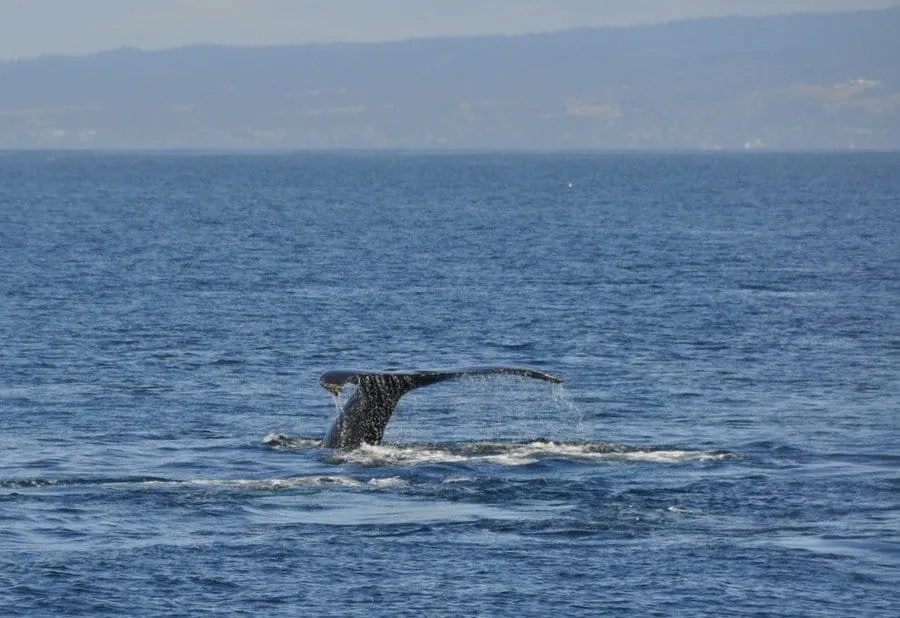
Contents
Where is Monterey Bay?
Monterey Bay, California lies on the west coast of the US around 133 miles south of San Francisco. It’s a place of natural beauty with cobalt blue sky mirrored in a sparkling ocean. It looks much like any other ocean scene on a sunny day as gulls soar and white surf rolls over the water in the race to shore.
But beneath the ocean is one of the deepest canyons in the earth’s seabed and it’s brimming with life. Whale watching in Monterey Bay is epic. Stand on the shore and you’ll spot a whole lot of wildlife in the seas and if the season’s right you’ll have some whale sightings in Monterey Bay itself.
Marine Life in Monterey Bay
Take a boat out to the edge of the canyon on one of the Monterey whale watching trips and, if conditions are right, you’ll witness the nature of the Pacific in its full awe-inspiring glory. It’s a must-do activity on your California bucket list.
We saw killer whales, humpback whales, and a pod of over 300 common bottle nose dolphins. Blue whales are also spotted on the whale trips but we weren’t lucky enough to see any on the day we went. It’s not just about whale watching. Monterey has an abundance of sea wildlife and we saw harbour seals, sea otters, pelicans and many types of sea birds during our visit.
Monterey Bay Whale Watching
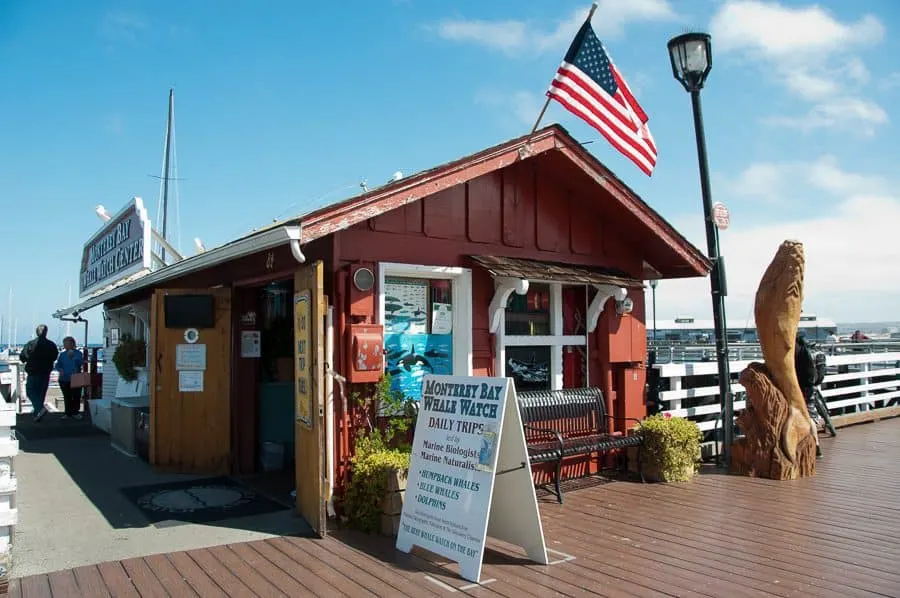
We walked down to Fisherman’s Wharf after filling up on ‘the best breakfast in town’ at Monterey Café and headed for the unimposing, brown, wooden hut belonging to Monterey Bay Whale Watch.
Although you can reserve places they won’t confirm or allow you to pay until they are sure that conditions are good enough to go out on the water.
We went on our whale watching trip in mid-September and the day dawned clear and blue with calm, sparkling sea. Perfect whale watching weather. We waited eagerly to board Seawolf, one of the company’s two boats.
We chug out of the harbour passing sea lions basking near the harbour wall, cute sea otters clinging to each other in the kelp beds and low-flying pelicans skimming the water.
Looking for somewhere to stay in Monterey Bay – check accommodation rates and availability
On Board Marine Biologist
On board, marine biologist, Kristin Robinson, tells us of the cetaceans that we may see on our whale watching trip. Some species pass by on their annual migration to feed at the edge of the canyon or mate in the area and others, like the grey whale, have made it their year-round habitat.
Once out to sea the engines ramp up and we cruise at a good speed across the water enjoying the sunshine and the salty breeze. Read about how to become a responsible Whale Watching Guide.
Suddenly, the engines slow and a hush of anticipation falls over the boat. Everyone’s scanning the seas for signs of life. An announcement over the PR system tells us we’ve stopped to pick up a deflated helium balloon. These land in the sea and cause huge problems for leatherback turtles and other wildlife so they’re always collected and safely disposed of along with plastic carrier bags. The disappointment onboard was palpable.
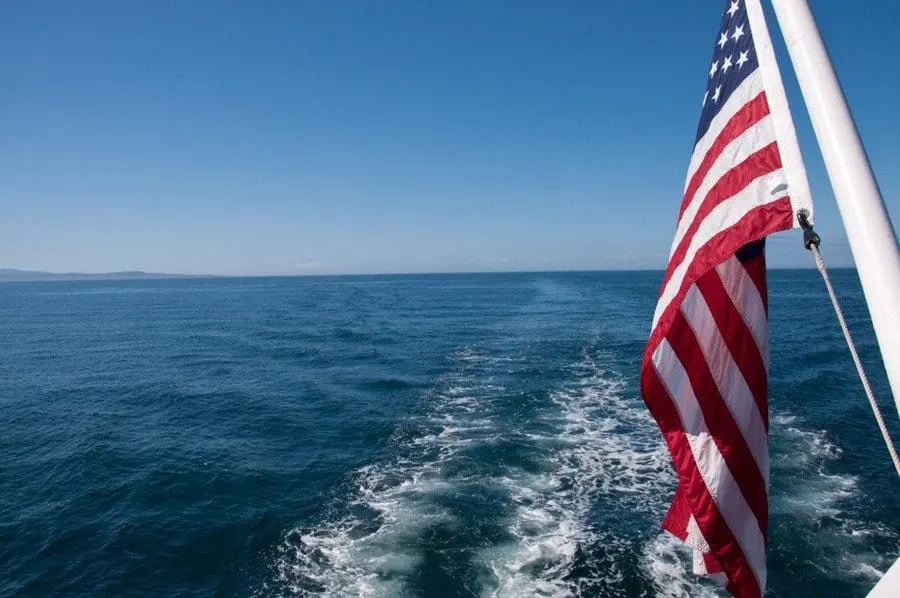
We’re off again heading in a different direction towards two other boats and there’s something out there. We slow down and spot the sun glinting off a wet, black, fin jutting from the water and there’s another, smaller fin. Orcas.
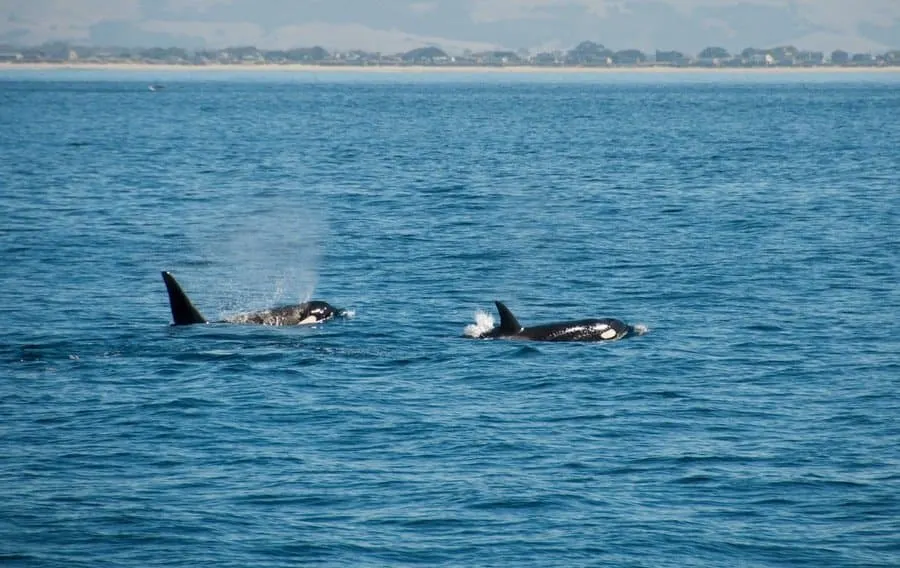
Orcas in Monterey
We’ve found a pod of killer whales. Seven Orcas in total and they’re fast; slipping in and out of the water displaying flashes of white as they break the surface to check us out.
The killer whales are huge with males ranging from 7 to 9 metres (23 to 30 ft) long weighing in excess of 6 tonnes with straight dorsal fins up to 2 metres high. The smaller females have a curved dorsal.
Long Beaked Common Dolphins
The boat is buzzing with excitement, but there’s more. Kristin asks us to look ahead of the boat, about 200m away, at a dark patch of water. I look closer and realise that the dark shadow is a moving, leaping mass of 200-300 hundred sleek, grey dolphins and they’re beautiful.
But things are about to kick off. The Orcas are looking for a kill and the long-beaked dolphins have no idea they’re being trailed. And then suddenly they do. Within seconds, the dark patch of water turns to a foaming frenzy as the dolphin sense danger and take flight leaping, darting and flashing through the water.
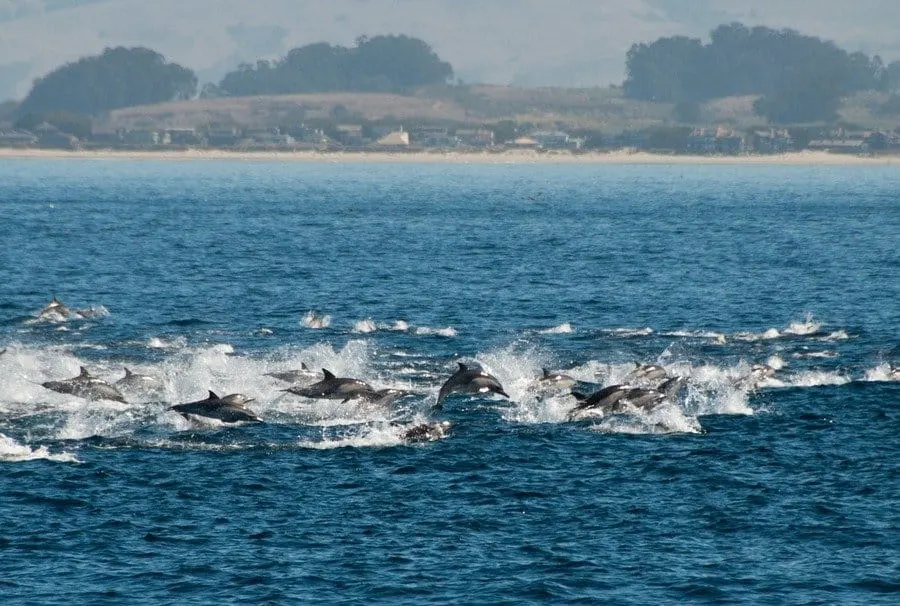
The Orca Make a Kill
The boat is keeping up with the Orcas and we motor alongside them watching as they single out a dolphin from the outside edge of the pod.
There’s a baby whale amongst the Orcas and they’re teaching it to hunt. They pop their heads out of the water to help locate their prey and we’re told this is called spy hopping.
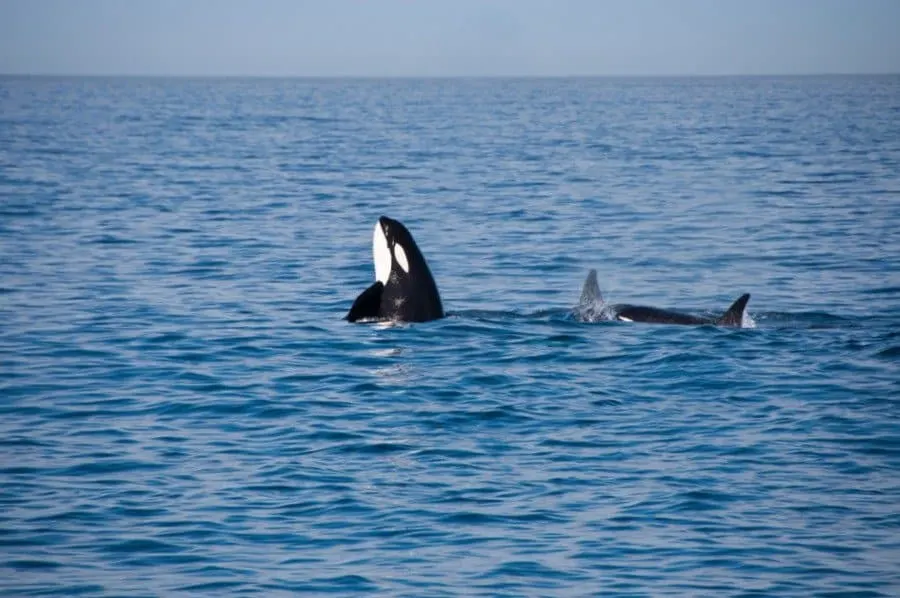
The pod of orcas pick out a dolphin to hunt down and, working as a team, separate it from the other dolphins circling, chasing, leaping and closing in until the dolphin is exhausted and defeated. It was amazing to see the Orca breaching as it hunted down its prey.
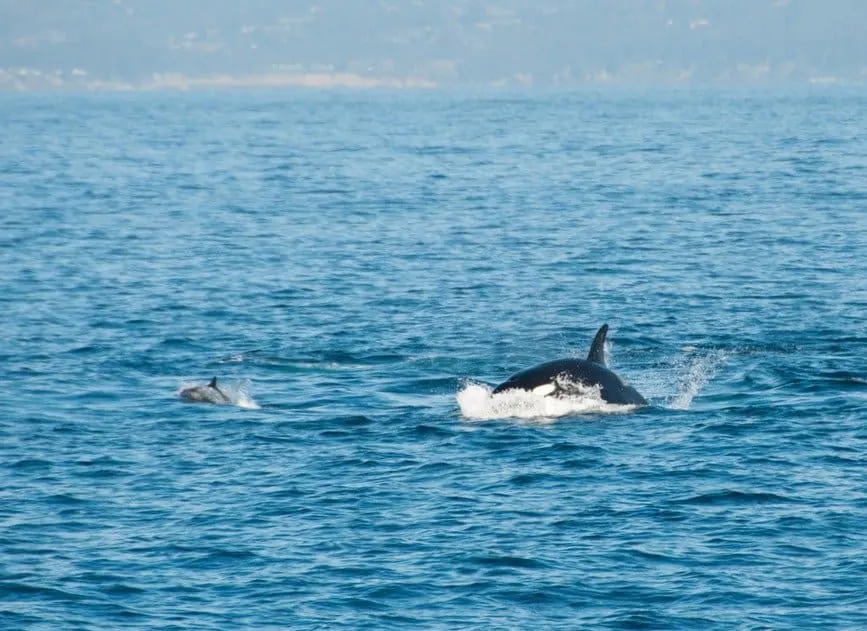
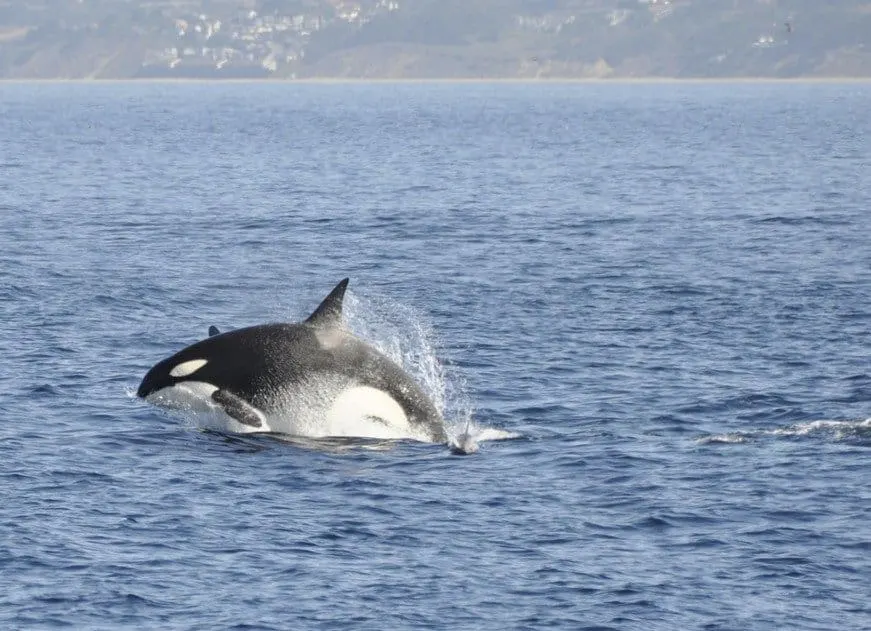
The Orcas form a feeding huddle, their noses dipping beneath the surface, fins piercing the water as they feed. The blubber is fuel and will keep them going longest. A spurt of blood-red seawater bursts from a blow hole.
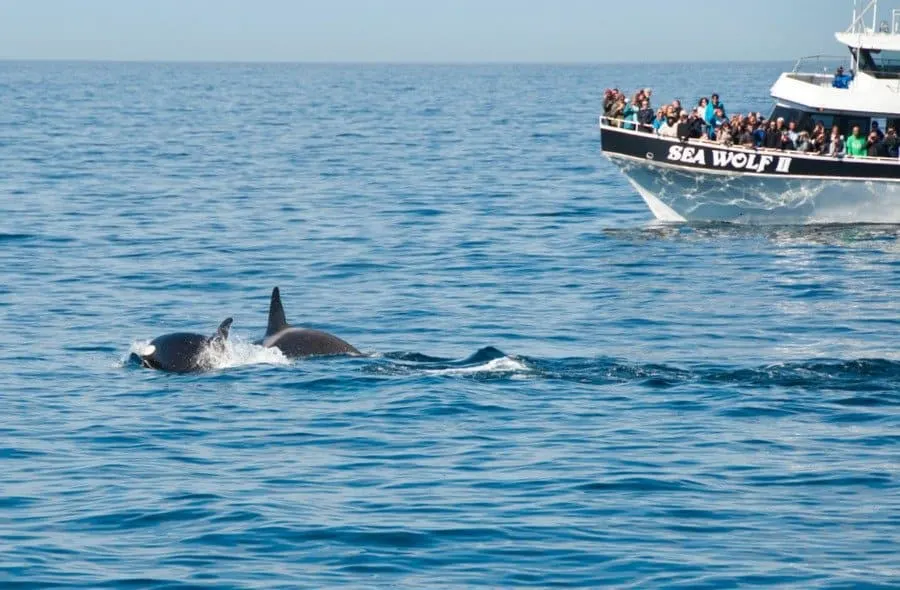
Monterey Humpback Whales
There’s more sealife in these waters and in the chase to hunt down their feed the Orcas have strayed into the territory of some huge Humpback Whales. True to form, they’ve got the hump about the intrusion and make it quite clear to the Orcas.
The humpbacks move in on the Orcas announcing their fury by grunting and bellowing loudly as they spout fountains of spray and slap the surface (pec-slapping) of the water with their huge, barnacle encrusted fins.
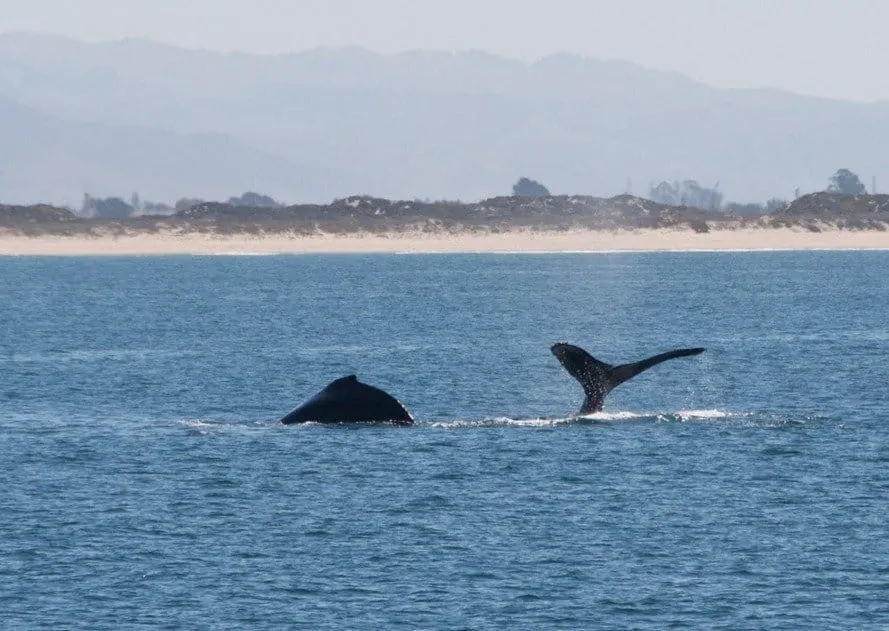
At this point we don’t know where to look first – we have the family of Orcas to the left of the boat, the pod of 300 dolphins ahead of us and to our right the unhappy humpbacks. Whale watching in Monterey Bay is, to this day, one of my most epic travel memories ever.
We can’t believe we witnessed these incredible displays of nature at such close quarters. The orcas heed the warnings and head off out to sea. This gives us a chance to check out the humpbacks as they wallow in the oily, anchovy laden waters.
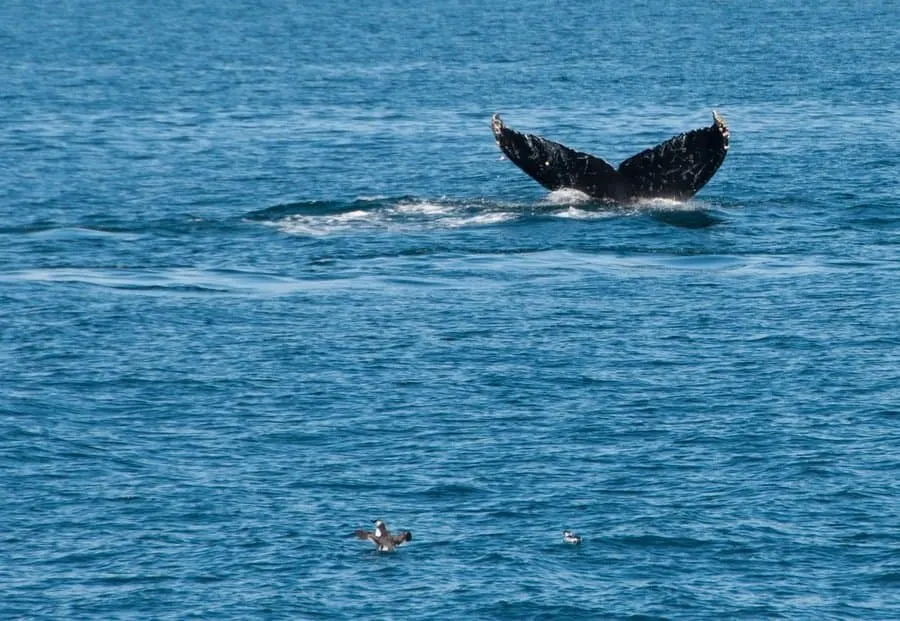
Whale Breaching and Flukes
The whales are huge, but they’re shy today and we don’t see a full breach. They roll sideways and flip lazily in the water before diving, exposing a fin or a shiny expanse of back.
The flukes (tail fins) are the last part of the massive creatures to disappear into the depths as they cascade waterfalls of sparking sea water. We can see jets of spray right into the distance and guess that around a dozen humpbacks are nearby.
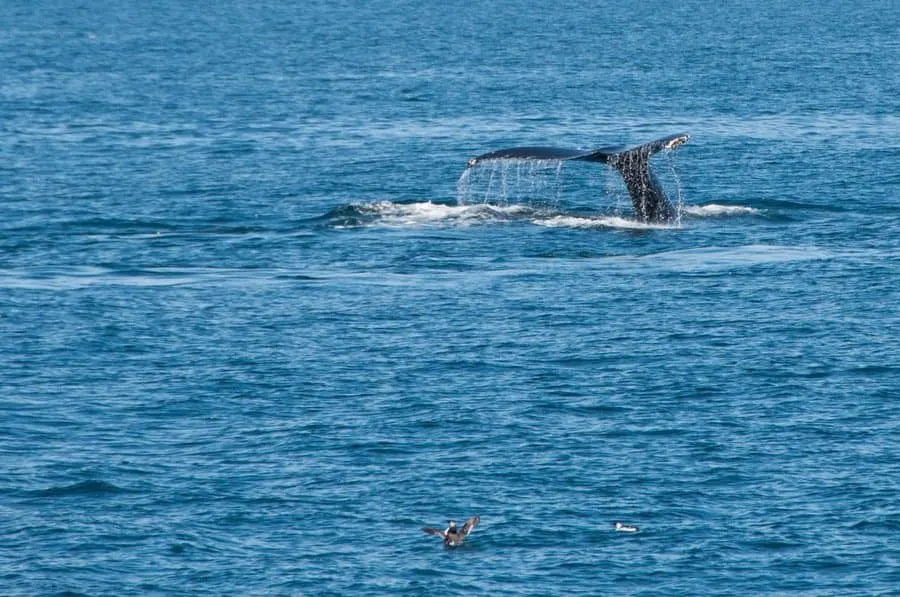
Kayaking in Monterey Bay is popular and we head over to some kayaks where more humpbacks are surfacing.
Just two days before a humpback breached over a kayak sucking the two British tourists deep in the water. Luckily they survived, shocked but unscathed – it hasn’t put people off. The whales are breaching just feet away from the kayaks.
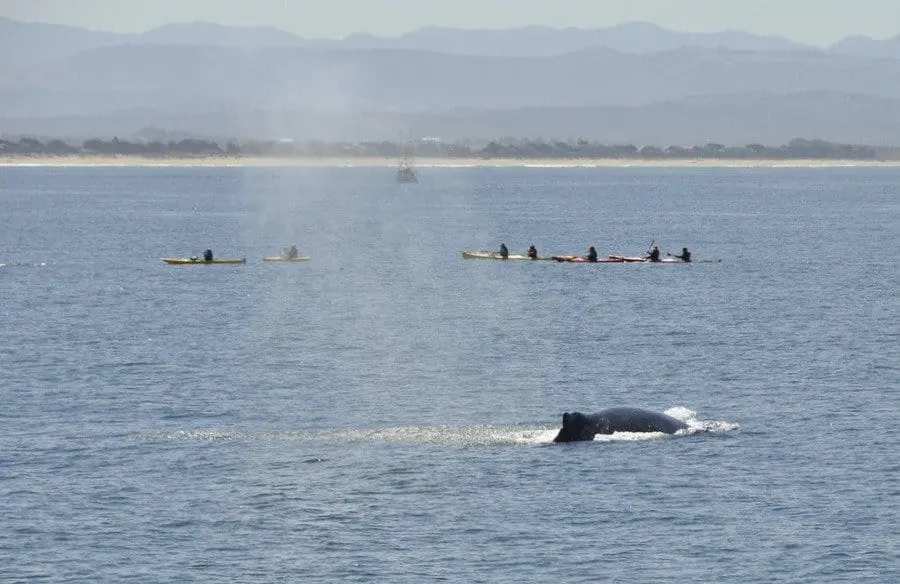
Two large whales dive deep for food leaving just two oily circles on the ocean’s surface. After feeding for 10-15 minutes they’ll reappear spurting jets of seawater high into the air as they surface. We don’t have time to wait for them to re-emerge as we’ve been out for around 3.5 hours and need to head back to shore.
The huge pod of dolphins, which have been near to us continuously swim up alongside the boat displaying one last graceful swim-past. They flash through the water, sleekly dipping and diving and then they’re gone.
It’s quiet now just the boat, the ocean and a warm breeze as we head back to harbour after an exhilarating morning’s whale watching. Finally, we spot sea otters basking in the sun as we near the harbour.
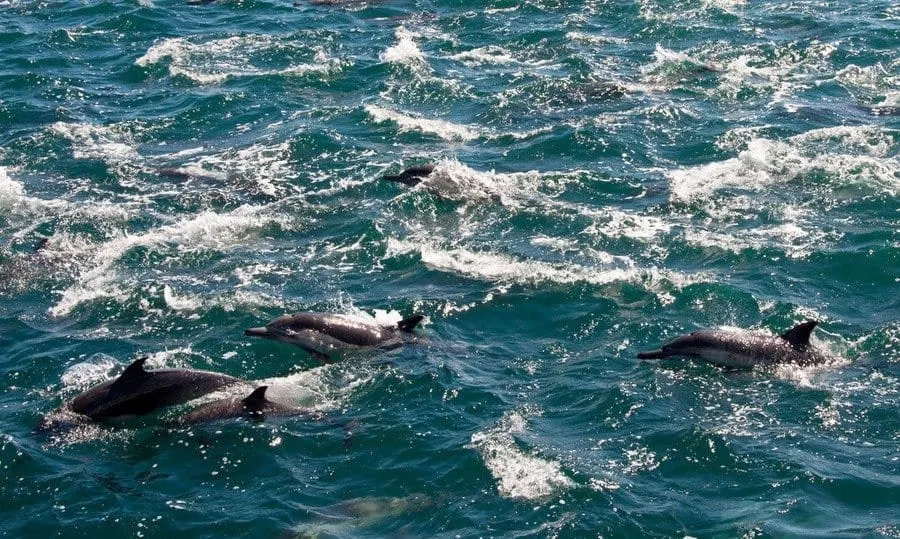
Best Whale Watching in Monterey Bay
Not all whale watching boat trips in Monterey are equal. Our whale watching tour was with Monterey Bay Whale Watch. We researched and chose our tour carefully.
Some of the other whale watching tours leaving from Fisherman’s Wharf use recorded commentary. How a recorded message can tell you about what you’re seeing right at that moment I’ll never know.
Monterey Bay Whale Watching has a marine biologist on board with excellent live commentary and their focus is on learning about the whales and their environment, conserving their habitat and being respectful towards them as living beings.
How to Book
Places can be reserved online or at the Whale Watch office but payment is taken on the day in case of bad weather. We took the 9am sailing as we figured the earlier 8am boat will have located the wildlife already and no time would be wasted searching.
We paid $49 per person for this trip which is excellent value. If no whales are sighted the company offer a free trip on another day. For this reason it’s good to book your whale watching tour early on in your trip so you have more time to reschedule if necessary. Previous day’s sightings are posted on their Facebook page so you can get an idea of what’s likely to be out there.
Whale Watching Season in Monterey
The best time for whale watching in Monterey for humpbacks, blue whales and dolphins is late spring, summer and autumn because that’s migration time. (April to mid-December).
In Winter and early spring (mid-December to March) you’ll still see grey whales and dolphins but not humpback whales, wlue Whales or orcas as they’ll have migrated by then.
For more Monterey wildlife visit Monterey Bay Aquarium. The aquarium is an amazing underwater world of sea life and is great for children who will love the interactive displays. There’s sustainability information underwater viewing spaces and the Aquarium makes a great day out.
Pin it for later…
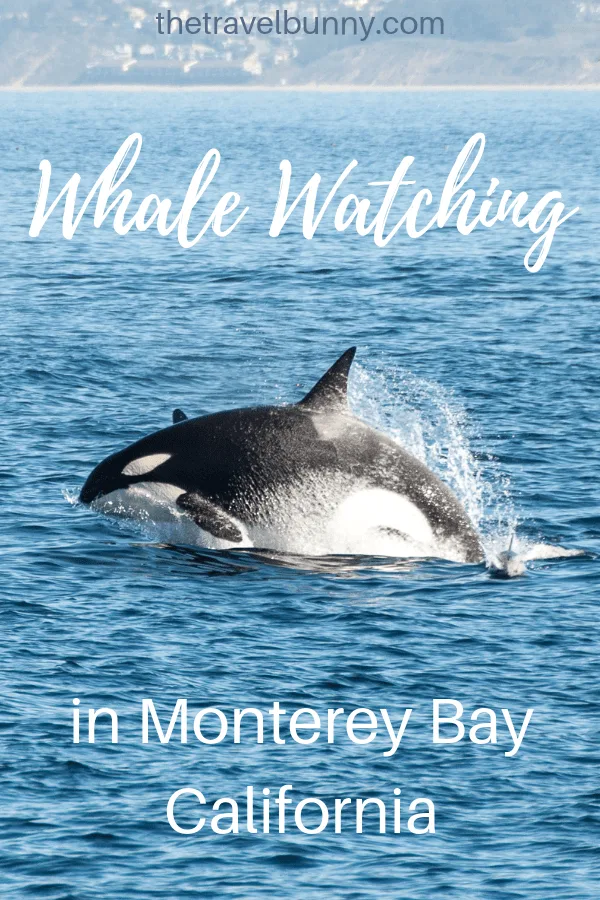
More road trip posts…
Road Trip Itinerary – South West USA
What to see and do in San Francisco
San Francisco – Biking the Golden Gate Bridge
San Francisco Highs at Coit Tower
Some of the links in this blog post are affiliate links. At no extra cost to you, I earn a small commission when you click on them and make a purchase. Thank you.

Suzanne Jones is a full-time travel blogger and writer at The Travelbunny which she started in 2011 during her time as a professional travel planner. Suzanne enjoys exploring new destinations, culinary encounters and the outdoors. When not travelling or writing about her adventures you’ll most likely find her, camera in hand, enjoying coastal walks in Sussex.
Suzanne also runs Hello Sussex a website which showcases the best of East & West Sussex. Read more about Suzanne.

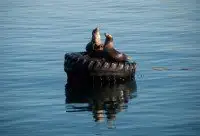
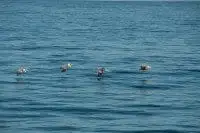
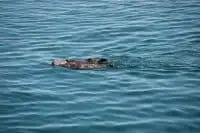
restlessjo
Monday 17th of December 2018
Fabulous post, Suze! You really bring it all to life. :) :) Have a wonderful Christmas, hon!
Suzanne Jones
Wednesday 19th of December 2018
Thanks Jo, it was one of my most memorable travel moments. Such a special day!
Suzanne Jones
Tuesday 18th of December 2018
Thanks Jo, we’ll do our best!
Christina Conte
Saturday 8th of December 2018
I love Monterey! Have gone to the aquarium a couple of times, but not gone whale watching there. Your photos look fabulous! It's so exciting to see whales and dolpins in the ocean!
Suzanne Jones
Sunday 9th of December 2018
This was one of my all time top travel moments - just incredible!
Crystalyn
Saturday 20th of October 2018
This is incredible! Honestly, a dream trip for me. Such amazing, beautiful creatures.
Suzanne Jones
Saturday 20th of October 2018
We were so privileged to experience it. A special day I’ll always remember.
Kathryn Burrington
Saturday 18th of August 2018
How fabulous! You've saw so many different species too. As you know, just yesterday I qualified as a responsible whale watching guide so I hope to see a lot more in the future too. I'd thoroughly recommend the course with the World Cetacean Alliance. I've learnt so much, not just about the whales and dolphins and their behaviour etc but also about how to inspire people to become involved in conservation work too. Blog post all about it coming soon!
Suzanne Jones
Sunday 19th of August 2018
It must have been a fascinating course. We saw a pod of orcas teaching a baby to hunt so it would be good to understand more about their behaviour and how the infant learned from it. Did feel a bit sorry for the poor dolphin though. I'm looking forward to reading your post.
Vixalexa
Thursday 3rd of March 2016
That whale is so cute! Thanks for share.